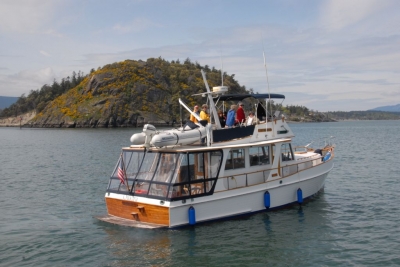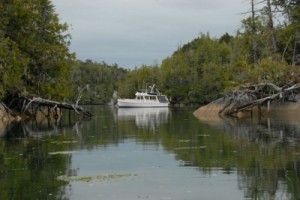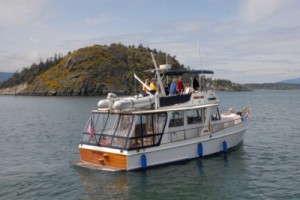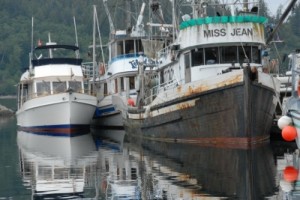Buying, Owning and Selling a Boat
A Familiar Melody
By Bob Lane
Photos by Bob Lane
I work with a many clients on both sides of the boat buying and selling process. These represent major emotional and financial transactions for both parties.
Here’s an inside look at what goes through one experienced boater’s mind and the tasks involved when on the selling side of the equation.
Steve D’Antonio
It is difficult to part with a loved boat, but keeping ahead of maintenance curve will keep the surprises to a minimum when the time comes to sell her.
It’s hard to believe that a pop tune from the ‘50s could change my boating outlook in 2012. But it has. I was driving home with favorite tunes flowing from the car speakers, enjoying the music on a rare sunny spring afternoon while following a forested road on Fidalgo Island. Suddenly, thoughts hidden in a wrinkle in my brain came to life with the suddenness of a beam sea rising from the darkness. The message was this: On the day you buy a boat, you should begin dealing with the idea that one day you will want to sell it.
This sounds strange, but the illumination occurred as the name of a tune stored in my IPod was displayed on the dash screen. It was a favorite on the jukebox when I was in high school: Teresa Brewer singing “Music! Music! Music!”
Why did a song by a pop star of the 1950s and 1960s rouse such a response? It’s simple: I began my boating life about the time her thumping rendition first pleased dancing teenagers and I enjoyed the tune despite being a non-musical sort and a poor dancer. I smiled when the song was delivered by an IPod (what would Teresa have thought about that?) but it also reminded me that I am competing for a spot in an Ancient Mariner competition. And, bluntly, the message that suddenly snapped on loud and clear was that after 22 years of ownership of a 42-foot Grand Banks Europa I should perhaps begin to think about moving ashore and handing the keys to someone else. Reflection soon convinced me it was not a new idea. I think nearly everything I have done to and with the boat over two decades was directed in part by the understanding that ownership was finite – that sooner or later we would part.
My passion for boating developed when I was a Sea Explorer Scout during my high school years. We cruised aboard a surplus Coast Guard 50-footer, equipped as I recall with only a liquid compass, a spotlight and a pair of gas burning Chrysler Royal engines. I bought my first boating “thing” – a seriously used 5hp Sears, Roebuck outboard motor — while I was in college and I hung it on the transom of rented kicker boats. My first boat was a 16-foot cedar-planked Poulsbo, purchased in 1969 or 1970 for about $600, in which I installed a Kermath Sea Pup (that’s a one-cylinder, 5hp gas marine engine built in the late 1940s). I’ve probably cruised about 6,000 hours in my years afloat, with family and friends aboard. But, the number of available cruising partners has dwindled in recent years.
There’s no substitute for an experienced crew. Those fortunate enough to have undertaken a passage with trusted mates relish the memory with good reason.
Last summer I had to shanghai three friends as crew for six weeks of cruising along the central coast of British Columbia. That was a wonderful experience –all three were knowledgeable boaters and fine people – but I arrived home fearing I never again could sign such a good crew and wondering if perhaps after four decades of boating the time was coming.
This mental effort further reminded of an earlier visit to the annual floating boat show on Seattle’s Lake Union, where I found Brian Pemberton and Scott Blake. Brian owns Northwest Explorations in Bellingham, Washington, a waterfront firm that manages a large fleet of Grand Banks yachts available for bare-boat charter. Scott is a salesman at Northwest Explorations who has sold GBs when his peers were having little success.
I asked some general questions about the market, which still was very much down at the time, and got some general answers. But I got one pointed comment from Brian, “People looking to buy a Grand Banks are not looking for a project.” I would not forget that message.
When a GB owner under charter with the Bellingham firm asks Brian and Scott to sell a boat, their first action is to call a surveyor. Yes, they survey a boat BEFORE it hits the market. Records of follow-up work or recommended improvements are attached to the survey and made available to buyers and their banks and insurance reps. There are no surprises that might upset a potential sale. That’s a good idea and I’m considering two surveys: one for the hull and general systems and the second for my Ford Lehman diesels and associated gear in the engine room. The Fords are totally reliable, but with more than 6,000 hours of running time potential buyers may ask challenging questions. A thorough check up and an appropriate follow up will reassure those who come looking.
Because of my interest in the immediate health of those diesels, I have had oil samples tested at the time of oil changes for about 15 years. I was reassured when every report came back indicating no unusual wear or other problems. Those reports, which should give equal reassurance to potential buyers, offer another example of doing something for today that also offers huge future benefits because, as we know, one oil sample tested at the time of a sale may not mean much. Before the surveys, however, I know there’s a lot to be done. And, I can do most of it without calling for professional help. I have enough life experiences aboard boats to be only a little bit dangerous when turned loose in my engine room.
As usual, I will follow my basic rule of boat repair and improvement: If a project requires experience I have, I will do the work. If it is a once-in-a-lifetime challenging event I will hire the $90- an-hour people. Therefore, I change oil and filters, service cooling systems, install simple electronics. I do not repair fuel injection pumps or rebuild transmissions or make major fiberglass repairs.
I intend to cruise this summer. (Crew needed!) My boat is not now for sale. But we, she and I, need to be ready for whatever the future brings. As experienced boaters know, most projects afloat are time consuming: it takes time to identify a problem, more time to order and wait for parts, time to schedule the project and to do the work. So, I have started out along a course to make her ready, hoping no one ever will look askance and declare her a project. And she’ll be a better boat for me, should I never hang a For Sale sign in the window. There’s no way my GB is a project, even though she is 33 years old. But there are some things I have tolerated, some things I have ignored and – I assume – some things needing care that I don’t know about. I needed to make a list and go to work. Be methodical. Start on the fly bridge and work down to the keel, making notes along the way.
However, I started at the bow by beginning work on known problems, including dismantling and resealing an always-faithful windlass to stop a small oil drip. The most challenging part was identifying the builder – there was no maker’s name on the windlass. I used reporter skills to identify it as a model 9B by R.C. Plath. Plath is still in business near Portland, Oregon, and still makes the 9B. I made one phone call and in a few days oil seals and O-rings were in my mailbox. I took the Honeywell 12VDC motor to a shop for service and whatever repair was needed. After this work was done, I learned the motor was installed as a replacement in 1986, so it’s younger than the boat. It was in fine condition, the technician told me, and needed only cleaning and new brushes.
While waiting for that project to come together, I turned to a pair of obvious problems: the acrylic skylight in the trunk cabin housing the master berth had cracked and two corners were broken, posing the likelihood of a leak, and the ice maker (original equipment dating from 1979) had given up during my summer cruise. The design of the skylight required some work with a router to accommodate the stainless steel strips that hold the new acrylic to the wood frame. That was beyond me, so I called for help from friends at Integrity Marine in Anacortes (they also had assisted in final assembly of the windlass.)
The ice maker problem was easily solved. It was a U-Line and I found the company still makes a unit with the same dimensions. Better yet, comparison shopping via the internet showed the best price was to be found not far from home, at Sure Marine in Seattle. It took me maybe an hour to install and I had ice in less than 30 minues. A walk-about inspection on deck revealed the need to replace the all-around white light atop the radar mast. The cap was gone with the wind somewhere and the lamp still lighted, but contacts were exposed and it was time for something new. It’s good I don’t have fat fingers because dealing with a skein of wires in the narrow wiring run in the center of the mast was a challenge. I found a couple of teak plugs missing from the bridge deck and made notes on my worksheet.
Cosmetically, the exterior is good. I can find flaws in my varnish work, but many boaters think (a) the boat is much newer or (b) it had been painted. No, it’s a ’79 and there is no paint on her. Grand Banks did well so many years ago. I’ve had good luck finding skilled folk to repair gel coat nicks and dings. (One of them explored a couple of small holes in the flybridge and discovered pellets from an air rifle embedded there. I often wonder why anyone would want to shoot up a nice old boat.)
My visit to the engine room produced a list of things to do that generally would be part of what we call spring commissioning. They included the usual changing of fluids and filters to wondering why there were a few drips of coolant in the pans beneath the starboard engine. Also, I was a bit puzzled by the continued presence of an inch or so of water in the bilge. The boat was fitted with dripless shaft seals more than a year ago, so the bilge should be dry, shouldn’t it? I dipped a finger in the bilge water and conducted a taste test. It was fresh, not salt, to my relief. A search found small leaks in the galley. While I dealt with the dripping water, I think I’ll ask for professional help in replacing a failing throttle cable.
The electrical system below decks is nothing like the installation completed by GB when the boat was built in Singapore in late 1978. Perhaps sensing the need to improve the electrical system for an eventual sale, but arguing that it really would make cruising more satisfactory now, I have had contractors over two years replace the AC and DC breaker panels, clean up the wiring beneath the helm and install a new inverter. GB’s original DC wiring was all black and based on a simple system with only a couple of batteries. New equipment (not thought about in 1979) increased the need for 12-volt service and batteries were added and gear linked into the existing wiring in sort of a daisy-chain fashion.
Strange things also occurred. Technicians who installed the Webasto furnace more than a decade ago installed an-inline fuse, but provided no way to disconnect power to the unit other than in the DC breaker panel. Similarly, another group of technicians who installed the water maker provided a breaker in the DC panel, but not a switch at the unit, which was inconveniently 15 feet away and below the main deck. I corrected those defects and later Steve Tiefisher, an Anacortes marine technician, reworked all the major DC wiring to bring it as close as possible to complying with the recommended standards of the American Yacht and Boat Council. He also installed a Balmar charging-control system. That stuff finished, Steve and I sat on an engine stringer, looked around and talked and finally concluded that the electrical system in the engine room is about as good as it can get. We’ll see what a surveyor thinks. It works well for me now.
Quadra is ready for more cruising to remote locations. Planning and regular maintenance should make her safe and reliable – and ready for her next owner.
To be sure everything is ready to perform, the boat needs testing. I have a couple of yacht club long weekends coming up and I intend to have every system running as we cruise into the San Juan Islands. Also, I will give the engines the ultimate trial of operating at wide open throttle to test them under severe loads. Steve D’Antonio described this test procedure in the April 2012 issue of PassageMaker Magazine. Read it and follow his advice.
Looking back, I think the subliminal concern for eventual resale must have developed soon after buying the boat. Although the systems and improvements were intended to enrich our cruising experience, it’s apparent they should do the same for another owner.
My goal is to do so well cleaning items from my list that potential buyers (some day in the future) will find nothing to shake their heads over or to make them run. There’ll be no “gotchas,” I hope. Returning to the music I opened with: Teresa Brewer recorded the tune as the “B” song on a record in December, 1949, when she was about 18 years old. Although she recorded more than 600 songs in a long career, Music! Music! Music! is the one most people remember. I first heard the tune played on what we called a jukebox at a class party at a small lake resort and I was 16 or 17 (I say that because I remember driving a 1936 model Plymouth coupe to the party.) In her bouncy song, Teresa said all she needed was “loving you” and “music, music, music.” And that would always be available, she sang, by putting “another nickel in the nickelodeon. . .”
Were that so with boats.
For more information on the services provided by Steve D’Antonio Marine Consulting, Inc. please e mail Steve at info@stevedmarineconsulting.com
or call 804-776-0981






